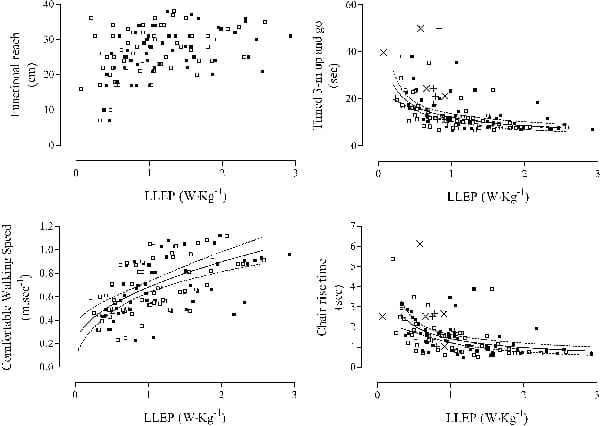Reduced lower limb extensor power (LLEP) is associated with poor performance of functional tasks in healthy people (1). Little is known about LLEP after stroke, other than it is lower than in healthy people when matched for age and gender (2) and that the impairment is bilateral, suggesting the involvement of factors not directly caused by the stroke. We hypothesised that low values of LLEP would be associated with reduced physical function and increased disability after stroke. LLEP (W kg-1) was determined for each leg in 66 ambulatory stroke survivors (mean (SD): age 72 (10) years, wt 72.6 (15.3) kg, ht 1.67 (8.59) m), using a Nottingham Power Rig (3). We measured physical function (comfortable walking velocity, functional reach, chair rise time and 3-metre timed up-and-go), and disability (Functional Independence Measure, Rivermead Mobility Index and Nottingham Extended ADL). The associations between LLEP and both function and disability were analysed using stepwise multiple linear regression models which included the likely confounding factors age, gender, time since stroke, smoking and use of walking aids. The median value of LLEP of the affected limb (LLEPaff 0.92 W kg-1) was significantly lower than that of the unaffected limb (LLEPunaff 1.05 W kg-1; p=0.002) but the difference was small (~10%). Low LLEP of either limb was associated with poor performance in each measure of physical function (p<0.0001) and was the exclusive predictor of those which were dynamic (walking, chair rise and timed up-and-go). LLEP showed pronounced curvilinear associations with chair rise time and timed up-and-go, with reductions in performance when LLEP was below 1.0 W kg-1 but with no increase in performance above this value (Fig. 1). Low LLEP was also associated with poor scores in each measure of disability; these associations were strongest for the affected side (p<0.0001) with LLEPaff being the only predictor from among the variables included in the regression models. The ratio of LLEPaff/LLEPunaff had no predictive importance for any measure of function or disability. In ambulatory stroke survivors reduced performance of physical function and increased disability are associated with deficits in LLEP of both lower limbs, and not the severity of any residual asymmetry. Interventions to increase LLEP in both legs might improve function and reduce disability after stroke.
University College London 2006 (2006) Proc Physiol Soc 3, PC120
Poster Communications: Disability in ambulatory stroke survivors is associated with impaired explosive power in both lower limbs
David H Saunders2, Carolyn A Greig1, Archie Young1, Gillian E Mead1
1. Clinical and Surgical Sciences, University of Edinburgh, Edinburgh, United Kingdom. 2. Scottish Centre for Physical Education, Sport and Leisure Studies, University of Edinburgh, Edinburgh, United Kingdom.
View other abstracts by:
Figure 1. LLEP of the affected (filled symbol) and unaffected (unfilled) lower limbs and specific disabilities. x (affected) and + (unaffected) denote use of arms for chair rise. Where LLEP was the only significant independent variable its regression coefficient (from transformed data) was used to generate a best fit line (and 95% CI) on the untransformed non-linear data (for clarity shown only on the unaffected side).
Where applicable, experiments conform with Society ethical requirements.

